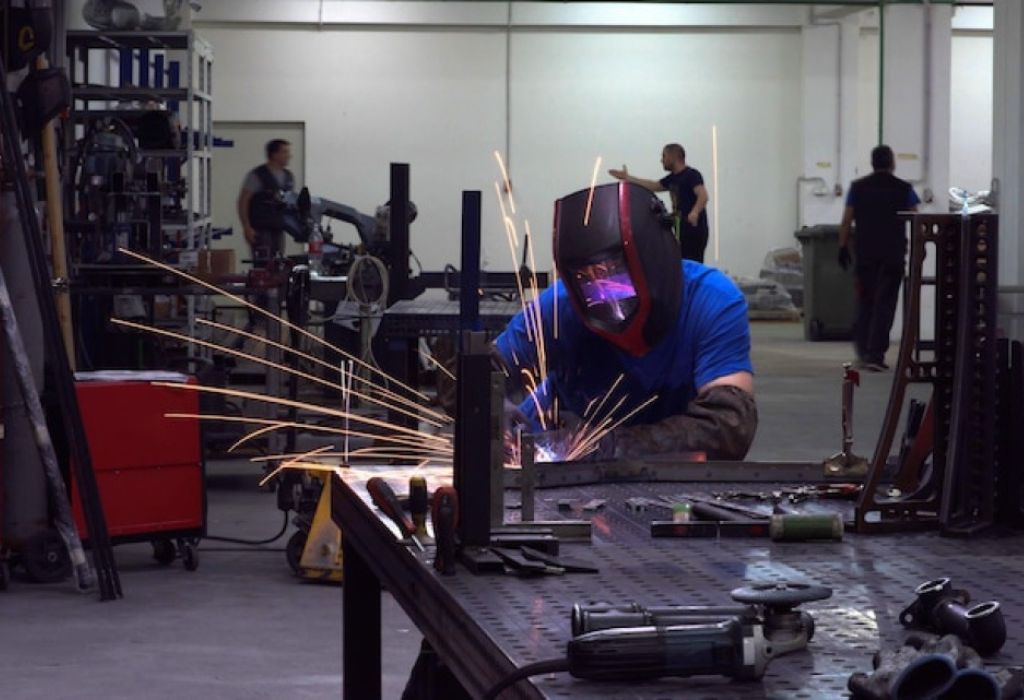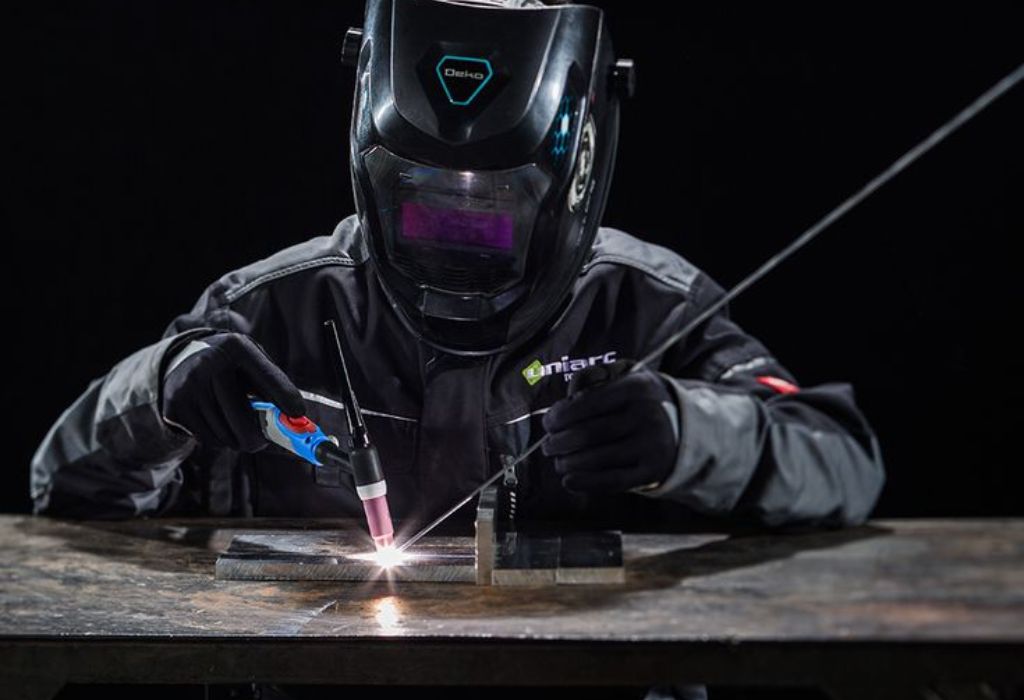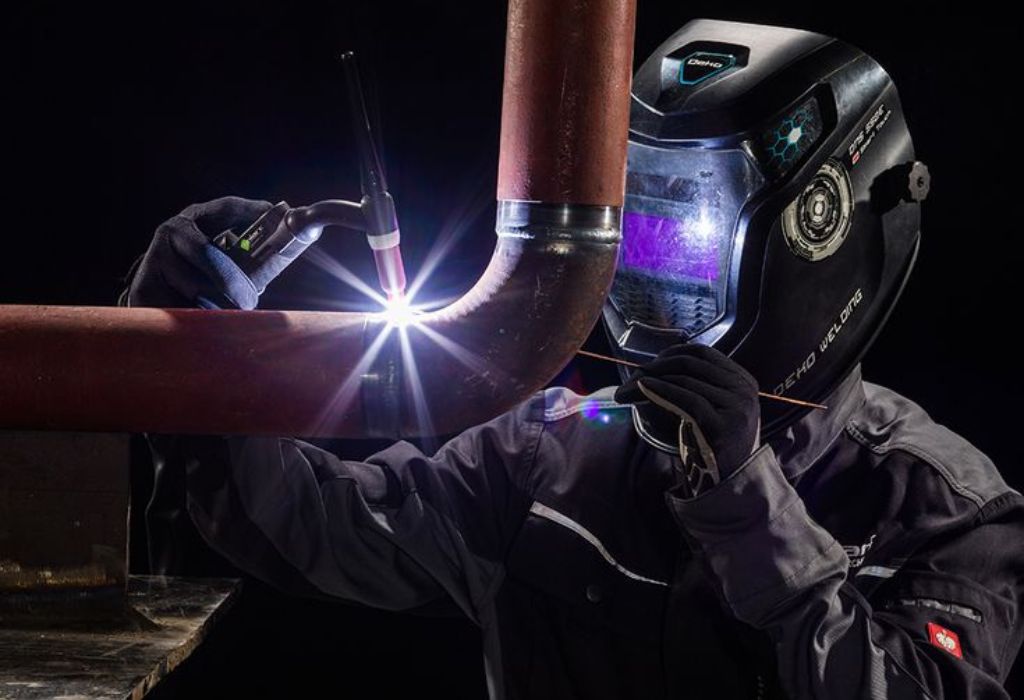Picture a welder standing on a ship’s deck as sparks flash beneath storm clouds. Waves crash, metal hums, and electricity arcs between steel plates. None of this would be possible without a machine that produces current for welding — the silent powerhouse driving every molten bead.
This machine, known as the welding power source, transforms ordinary electrical energy into the precise, controlled current that fuses metal safely and efficiently.
Without it, arcs would be unstable, welds would fail, and entire industries — from shipbuilding to aerospace — would come to a halt.
According to the American Welding Society, over 70% of all manufactured products involve some form of welding .
That’s billions of joints relying on power sources designed to deliver the right voltage, amperage, and duty cycle under extreme conditions.
In this guide, you’ll learn what this machine is, how it works, the difference between transformer and inverter types, how constant current (CC) and constant voltage (CV) systems operate, and how to choose the right one for your welding process.
What Is a Machine That Produces Current for Welding?

At its core, a welding power source converts standard electrical input (AC or DC) into controlled current suitable for forming a stable welding arc. This current melts both the base metal and filler material, creating a strong bond once cooled.
The machine can be powered by electricity from the grid, batteries, or even an internal combustion engine (as in engine-driven welders). Its job is not to “create” power from nothing, but to regulate and deliver it in a way the arc can use safely.
What does it actually produce?
It produces electrical current (amperage) at a controlled voltage to maintain a steady arc during welding.
Why does the welding process matter?
Different processes require different power behaviors. Stick and TIG welding rely on constant current (CC), while MIG and flux-core welding need constant voltage (CV).
Is it the same as a generator?
Engine-driven welders include a built-in generator to create power but still function as a power source for the arc.
What key specs define a welding machine?
The most important are amperage range, voltage range, duty cycle, and whether the machine operates in CC or CV mode.
How Welding Power Sources Work
A machine that produces current for welding doesn’t just “send electricity.” It transforms, rectifies, and stabilizes it.
Three main types of systems dominate today’s welding industry: transformer, rectifier, and inverter power sources. Each performs the same basic task — converting high-voltage, low-current input into low-voltage, high-current output — but in different ways.
Transformer and Transformer-Rectifier Machines
Traditional transformer machines rely on electromagnetic induction. They step down mains voltage (e.g., 230 V or 415 V) to a low voltage (20–80 V) suitable for arc welding. The result is high current, ideal for deep penetration and heavy-duty work.
Transformer-rectifier machines improve this design by adding rectifiers that convert AC to DC output, which is smoother, more stable, and preferred for TIG and Stick welding.
Which is more portable?
Transformers are sturdy but heavy. They’re best for workshops, not mobile sites.
Which lasts longer?
Transformer machines can run for decades with minimal maintenance.
Why add a rectifier?
It provides DC output, improving arc stability and penetration.
Is three-phase power better?
Yes, it supports higher amperage and smoother performance for industrial work.
Inverter Power Sources
Inverter welders represent modern technology. They use electronic circuitry (IGBTs and PWM control) to switch power thousands of times per second, drastically reducing transformer size and increasing efficiency.
This results in lighter, smarter, and more portable welders capable of running multiple processes in one machine.
Are inverter welders reliable?
Yes, especially when built with quality components and protection circuits.
What makes them more efficient?
They waste less energy as heat and provide precise control over arc characteristics.
Do they cost more?
Initially yes, but energy savings and versatility offset the price.
Can inverters handle all processes?
Many are multi-process machines supporting MIG, TIG, Stick, and even plasma cutting.
Constant Current (CC) vs Constant Voltage (CV) Systems
Different welding processes require different electrical behavior.
Constant Current (CC) machines maintain steady amperage even when the arc length changes. This consistency is critical in Stick (SMAW) and TIG (GTAW) welding, where manual control causes frequent fluctuations.
Constant Voltage (CV) machines keep voltage stable, letting the wire feed system automatically adjust current. This self-regulating feature makes MIG (GMAW) and Flux-Cored (FCAW) processes smooth and easy to learn.
Why does MIG prefer CV?
Because constant voltage ensures a balanced burn-off rate between the wire feed and the arc.
Why does TIG prefer CC?
Because precise amperage control prevents overheating thin materials.
Can one machine do both?
Yes. Most modern inverters have both CC and CV modes.
Do these settings affect arc stability?
Absolutely. Matching the correct output mode to the process ensures consistent penetration and weld quality.
Electrical Fundamentals in Welding Power Sources

Understanding electrical behavior helps you appreciate how these machines operate safely and effectively.
Amperage, Voltage, and Polarity
Amperage (current) controls penetration — higher amperage melts deeper into the base metal.
Voltage controls arc length and bead width. Too high causes spatter; too low causes sticking.
Polarity also matters. DC-positive (DCEP) provides deeper penetration, while DC-negative (DCEN) offers faster deposition. Alternating current (AC) combines both for materials like aluminum.
Why does polarity matter?
It determines heat distribution between electrode and workpiece.
When use AC?
For aluminum TIG welding, where oxide cleaning action is required.
Can polarity affect electrode life?
Yes. Wrong polarity overheats and shortens electrode lifespan.
Open-Circuit Voltage (OCV)
OCV is the voltage present when the welder is powered but no arc exists. It helps start the arc smoothly.
Typical OCV ranges between 50–100 V, depending on process and safety standards.
Is higher OCV better?
It improves arc starts but must stay within safe limits.
Why reduce OCV in some environments?
To prevent electric shock risks, especially in damp or confined spaces.
Duty Cycle
Duty cycle tells how long the welder can operate before needing to cool down. It’s expressed as a percentage of a 10-minute cycle.
For example, 40% duty cycle at 200 A means you can weld for 4 minutes continuously before cooling for 6 minutes.
Why is duty cycle important?
It affects productivity and determines machine durability.
What happens if it’s exceeded?
The machine overheats and automatically shuts down.
How to increase duty cycle?
Use lower amperage or choose a higher-capacity power source.
Types of Welding Machines That Produce Current
Several configurations exist, each designed for specific environments and welding methods.
1. Mains-Powered Machines
Plug directly into wall outlets or industrial supply lines. Ideal for workshops and factories.
When to use?
For consistent shop work where power is stable.
2. Engine-Driven Welders
These machines generate their own electricity via gasoline or diesel engines. Perfect for fieldwork or remote job sites.
Why use engine-driven units?
They provide autonomy and can power other tools simultaneously.
3. Inverter Multi-Process Welders
Compact and versatile, they switch between MIG, TIG, and Stick modes at the press of a button.
Who benefits most?
Mobile fabricators, repair technicians, and small workshops.
4. Battery-Powered or Portable Units
Emerging technology using lithium-ion packs for on-the-go maintenance jobs. Still limited in duration but improving rapidly.
Selecting the Right Welding Power Source
Choosing a machine that produces current for welding involves matching your requirements to key specifications.
1. Identify the metal type and thickness.
Mild steel, stainless, or aluminum each need different power characteristics.
2. Determine your environment.
Workshops can use heavy transformers; mobile welders need portable inverters or engine drives.
3. Check your power supply.
120 V for light tasks, 240 V for thicker steel, and 3-phase for industrial loads.
4. Consider the duty cycle and amperage range.
Select a machine that operates comfortably at your average amperage.
5. Evaluate features and safety.
Look for thermal overload protection, fan-on-demand, voltage control, and digital displays.
What amperage for 1/4-inch steel with MIG?
Around 180–210 A depending on joint and wire type.
Which power input is ideal for workshops?
240 V or 3-phase ensures stable performance.
Should I buy multi-process?
Yes, if you handle varied materials and want flexibility.
How much headroom to allow?
At least 25% higher than your average working amperage.
Safety and Standards
Welding power sources must comply with safety codes like AWS, IEC 60974, and OSHA electrical standards.
Use machines with proper insulation, grounding, and low-voltage controls. Always maintain ventilation — even the best welder can’t compensate for toxic fume buildup.
Does higher OCV increase risk?
Yes. Always rely on manufacturer safety limits.
Which standards apply to welders?
AWS D1.1 for structures, OSHA for workplace safety, and IEC for equipment design.
Can I use a generator to power an inverter?
Yes, if the generator produces clean, stable sine-wave power and meets wattage requirements.
Why is grounding critical?
Improper grounding causes shock risk and erratic arcs.
Troubleshooting Power Source Issues

Even the best machines occasionally act up. Understanding electrical behavior helps diagnose quickly.
Why does the arc keep cutting out?
Check loose ground connections or power supply drops.
Why is the arc unstable in MIG mode?
Voltage fluctuations or incorrect wire speed.
Why does the welder overheat?
You’re exceeding the duty cycle — reduce amperage or increase rest periods.
Why won’t the arc start?
Inspect electrode connections, OCV level, and surface cleanliness.
Why is there too much spatter?
Voltage too high or improper polarity setting.
Future Trends in Welding Power Sources
The next generation of machines that produce current for welding are becoming smarter, lighter, and more connected.
AI-controlled inverters can automatically adjust voltage and current in real-time for perfect arcs. IoT integration lets supervisors track duty cycles, maintenance, and performance data remotely.
Battery-powered and hybrid welders are gaining ground for emergency field repairs, while robotic welding systems rely on ultra-precise inverter technology for repeatable results.
Will inverters replace transformers?
Yes, as efficiency and control continue to improve.
Are battery-powered welders practical yet?
For light repairs and mobile work, yes — though not for heavy fabrication.
Will robots replace human welders?
Not entirely. Complex and creative welding still needs skilled hands.
Is pulse welding becoming standard?
Yes, it’s now common even in mid-range inverters for better heat control.
Will data logging matter?
Absolutely. Logged current, voltage, and duration data ensure quality and traceability.
Conclusion
Every weld begins and ends with a machine that produces current for welding — the heart of the process. This power source controls the heat, stability, and penetration that determine weld strength and durability.
Understanding how it works helps you choose better, weld safer, and achieve consistent results. Whether you use a traditional transformer, a portable inverter, or an engine-driven generator, the principle remains the same: convert energy into a stable, controlled current that bonds metal into strength.
Final advice: Always size your welder for the job, match process to power source, and respect duty cycles. A properly chosen power source isn’t just equipment — it’s the foundation of every successful weld.

I’m Darrell Julian, the founder, lead writer, and hands-on welding enthusiast behind ArcWeldingPro.com. With more than 15 years of real-world welding experience, I created this platform to share what I’ve learned in the field, in the shop, and in the heat of the arc.


